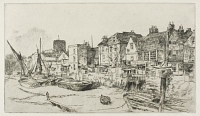The 'Adam and Eve', Old Chelsea | ||
| Number: | 182 | |
| Date: | 1878 | |
| Medium: | etching and drypoint | |
| Size: | 175 x 302 mm | |
| Signed: | butterfly at upper left (3) | |
| Inscribed: | no | |
| Set/Publication: | Hogarth and Son, 1879. | |
| No. of States: | 3 | |
| Known impressions: | 92 | |
| Catalogues: | K.175; M.172; W.144 | |
| Impressions taken from this plate (92) | ||
TECHNIQUE
This is mainly etching, with drypoint used to add emphasis in the foreground, and delicate sky effects in the background. Lochnan comments:
'In "the Adam and Eve", Old Chelsea he suggested light by means of shadow, and the whole by drawing a part. ...
Whistler's concern was not so much to express the physical nature of the structure but to create a feeling of air and atmosphere, and a composition based on oriental principles of balance and placement. In this work the eye is no longer drawn to a specific area of the composition; instead it is drawn to different areas wherever details congregate. By drawing only the shadow and the light within the shadow, Whistler created a new sense of aerial perspective which is not found in the etchings of 1859.' 19
PRINTING
There was a very large edition of over 100 impressions of this etching. Two thirds of these are in the final state (i.e. ).
Early impressions were printed in black ink on medium weight 'antique' (pre-1800) laid paper with Arms of Amsterdam watermark (); buff laid with a countermark, possibly 'ID' (); cream laid paper removed from a book with an old Latin inscription in brown ink on the verso (); off-white paper from a ledger (); and off-white Japanese paper (, ).
The main edition, also printed in black ink, was also on a variety of paper. Western papers included off-white 'antique' laid (); cream 'modern' laid (); ivory () and buff laid (); thick buff laid (); and thin ivory wove ().
Asian papers predominated, and included dark ivory () and cream Japan (, , , , ); light grey chine appliqué (, ); ivory Asian laid (); Asian laid backed with white Asian wove paper (); tan chine collé (); thin tissue-like ivory Japan (); cream Asian laid (, ); and cream Asian wove ().
It is possible that Peter J. Platt, a copper plate printer from New York, printed impressions from the plate (which is inscribed with his name) in the period after 1905.
